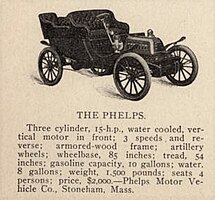The Locomobile Company of America was a pioneering American automobile manufacturer founded in 1899, and known for its dedication to precision before the assembly-line era. It was one of the earliest car manufacturers in the advent of the automobile age. For the first two years after its founding, the company was located in Watertown, Massachusetts. Production was transferred to Bridgeport, Connecticut, in 1900, where it remained until the company's demise in 1929. The company manufactured affordable, small steam cars until 1903, when production switched entirely to internal combustion-powered luxury automobiles. Locomobile was taken over in 1922 by Durant Motors and eventually went out of business in 1929. All cars ever produced by the original company were always sold under the brand name Locomobile.

The Brass Era is an American term for the early period of automotive manufacturing, named for the prominent brass fittings used during this time for such things as lights and radiators. It is generally considered to encompass 1896 through 1915, a time when these vehicles were often referred to as horseless carriages.
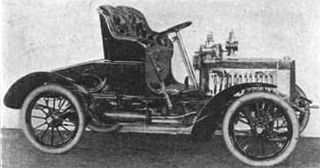
Eisenhuth Horseless Vehicle Company was a manufacturer of Brass Age automobiles who were originally based in New York City. In 1902 the company purchased the Keating Wheel and Automobile Company and established manufacturing operations in Middletown, Connecticut. During 1903, the company merged with the Graham Fox Motor Car Company, absorbing that firm and expanding operations in Middletown.
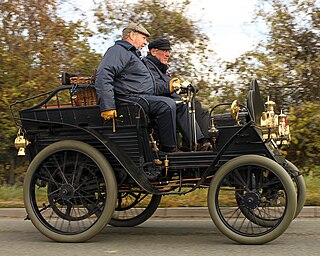
The Mors automobile factory was an early French car manufacturer. It was one of the first to take part in automobile racing, beginning in 1897, due to the belief of the company founder, Émile Mors, in racing's technical and promotional benefits. By the turn of the century, automobile racing had become largely a contest between Mors and Panhard et Levassor.

St. Louis Motor Carriage Company was a manufacturer of automobiles at 1211–13 North Vandeventer Avenue in St. Louis, Missouri, founded by George Preston Dorris and John L. French in 1898, with French taking charge of marketing and Dorris heading engineering and production. St. Louis Motor Carriage was the first of many St. Louis automakers and produced automobiles from 1899 to 1907.

The first Cadillac automobiles were the 1903 Model built in the last quarter of 1902. These were 2-seater "horseless carriages" powered by a reliable and sturdy 10 hp (7 kW) single-cylinder engine developed by Henry Martyn Leland and built by Leland and Faulconer Manufacturing Company of Detroit, of which Henry Leland was founder, vice-president and general manager.

Jean Joseph Étienne Lenoir, also known as Jean J. Lenoir, was a Belgian-French engineer who developed the internal combustion engine in 1858. Prior designs for such engines were patented as early as 1807, but none were commercially successful. Lenoir's engine was commercialized in sufficient quantities to be considered a success, a first for the internal combustion engine.

Columbia was an American brand of automobiles produced by a group of companies in the United States. They included the Pope Manufacturing Company of Hartford, Connecticut, the Electric Vehicle Company, and an entity of brief existence in 1899, the Columbia Automobile Company.

The Benz Patent-Motorwagen, built in 1885 by the German Carl Benz, is widely regarded as the world's first practical modern automobile, a self-propelled vehicle for carrying people, and first car put into series production. It was patented and unveiled in 1886. The original cost of the vehicle in 1886 was 600 imperial German marks, approximately 150 US dollars.
The Garrard & Blumfield or Blumfield & Garrard was an English electric car manufacturer from 1894 to 1896. The company is presumed to have been founded by C. R. Garrard and T. W. Blumfield.
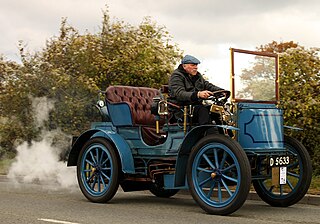
Gardner-Serpollet was a French manufacturer of steam-powered cars in the early 20th century. Léon Serpollet is credited with inventing and perfecting the flash boiler in the late 1800s.

The Union automobile was a vehicle manufactured by the Union Automobile Company from 1902 until 1905. It was designed by John William Lambert, who had developed the three-wheel Buckeye gasoline buggy in 1891. Over the next decade, Lambert substantially refined the vehicle, with modifications including an additional wheel, a more powerful engine, and a new transmission system. The Union Automobile Company was formed as a subsidiary of Lambert's Buckeye Manufacturing Company solely to manufacture the Union, which took its name from Union City, Indiana, the city where it was built and which endorsed its production. In total, the company built over three hundred Union automobiles, before development shifted to the Lambert automobile, the Union's successor.

The Moline Automobile Company, was an American brass era automobile manufacturer in East Moline, Illinois known for the Moline, Dreadnought Moline,Moline-Knight and R & V Knight marques.
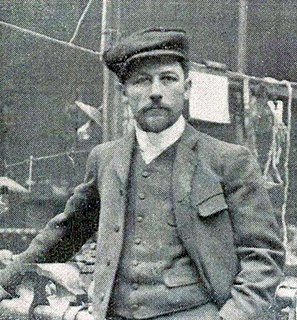
Léon Serpollet was a French engineer and developer of flash steam boilers and steam automobiles.

The Union Automobile Company was an automobile factory to manufacture the Union automobile through the Buckeye Manufacturing Company. It began manufacturing automobiles in 1902 and produced them through 1905. The company was located in Union City, Indiana. The inventor of Union automobile gasoline engine and friction drive gearless transmission was John W. Lambert. In the early part of 1905 the company moved to Anderson, Indiana. It had produced 325 automobiles before going out of business in the later part of 1905. It was replaced with a redesigned model that became the Lambert automobile.
The Pierce Engine Company of Racine, Wisconsin, was the manufacturer of the brass era Pierce-Racine automobile. The company was founded in 1892 and produced automobiles from 1904 to 1910.

The Worthington Automobile Company was a short-lived automobile manufacturer in the United States that made automobiles between 1904 and 1905.
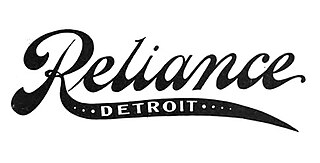
The Brass era Reliance automobile was manufactured by the Reliance Automobile Manufacturing Company in Detroit, Michigan from 1904 to 1907.

The Shawmut Motor Company was organized in Stoneham, Massachusetts in 1905 to succeed the Phelps automobile. The Shawmut was manufactured from 1906 to 1908, when the factory was destroyed by fire. The company was headquartered in Boston. A 1908 Shawmut Roundabout was the winner of the 1909 Ocean to Ocean Automobile Endurance Contest.
The Welch Motor Company was an American automobile company headquartered in Chelsea, Michigan. It started in 1901 and continued production of luxury vehicles until 1911 when it merged with General Motors.




